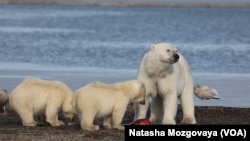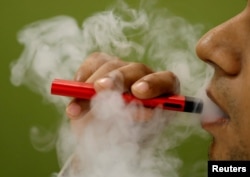In the Arctic region, the effects of climate change are occurring at a heightened rate, with temperatures increasing at a rate two to four times greater than the worldwide average.
Vladimir Romanovsky, a geophysicist at the University of Alaska in Fairbanks, describes it as polar amplification. He explains that during melting periods, snow and ice reflect a significant amount of energy back into space. However, when the surface darkens due to melting, it absorbs more energy, resulting in a warmer surface and atmosphere.
Residents of communities located in the circumpolar regions of Alaska are facing a trio of difficulties caused by climate change. These include coastal erosion, melting of the underlying permafrost that supports buildings and infrastructure, and the added challenge of coexisting with apex predators, particularly polar bears driven onto land.
According to Todd Atwood, a wildlife biologist from the United States Geological Survey, the ideal environment for polar bears is currently scarce and has essentially vanished. After 12 years of researching these animals, he explains that the diminishing sea ice has made it more challenging for polar bears to catch seals.
“That typically prompts bears to either remain on the sea ice as it recedes into deeper waters, or for an increasing number of bears to swim to shore.”
Furthermore, bears attempting to transition to life on land not only face the danger of succumbing to harsh ocean conditions during long swims, but also encounter added risks while foraging for sustenance in unfamiliar territory.
“They are arriving on land in locations where there is human activity, whether it be near communities engaged in subsistence activities or within the oil and gas industrial area where people work outdoors regularly,” stated Atwood. “This increases the chances of human-bear interactions and potential conflicts.”
Posters in Kaktovik, an Inupiat village on Alaska’s North Slope, caution residents to remain vigilant for polar bears.
Before the COVID-19 pandemic, Kaktovik, located 600 kilometers away from the nearest major city, welcomed tourists for polar bear tours. However, due to the pandemic, these restrictions have been lifted. Currently, the main hotel is occupied by contractors who are working to finish repairs on the local school and ensure that infrastructure is maintained before the onset of harsh winter weather and darkness.
Lee Kyoutak greets guests at the landing strip where small aircrafts carrying limited passengers and resources arrive when the island’s often foggy conditions permit. He assures visitors not to be concerned about any noises that may sound like gunshots or fireworks, as the village is regularly monitored by a polar bear patrol. He advises caution when venturing outside, as polar bears have been known to frequent the area.
Kaktovik is among six North Alaska communities where individuals are given specialized training by the North Slope Borough and the U.S. Fish and Wildlife Service to participate in Polar Bear Patrols. These patrols use non-lethal methods to deter bears from entering areas where humans reside or work.
In indigenous communities like Nuiqsut, Utqiagvik (Barrow), and Kaktovik that practice seasonal whale hunting, polar bears are drawn to the discarded bones of bowhead whales left outside the village. This keeps the patrols particularly occupied. Unfortunately, there have been instances where encounters between bears and humans have resulted in fatalities for both parties.
Robert Thompson, a guide for Inupiat wildlife, states that he seldomly goes out in the village without a weapon, especially during the night.
He recounted, “I was forced to shoot two bears that were pursuing me. It’s not something I want to do, but in a situation where bears are chasing you, you have to protect yourself. One bear was only four to five feet away from my doorway, while the other attempted to enter my house through my bedroom window.”
Over 50 years ago, Thompson arrived in Kaktovik. At that time, he recalls that there was always ice present during the summer months. This ice, known as pack ice, does not melt. However, in recent times, there has been a significant decrease in ice cover, with 700 miles of open water towards the North Pole. This has had a direct impact on polar bears, as they are now forced to swim to shore due to the melting ice. Unfortunately, this has resulted in many cubs not surviving the journey.
Researchers have observed polar bears enduring distances of up to 350 kilometers while swimming for multiple days. Despite their strength in the water, not all bears are able to overcome this arduous task.
According to a study conducted by the U.S. Geological Survey, the population of polar bears in the southern Beaufort Sea decreased by 40% in the first ten years of the 21st century.
The polar bear research community is certain that polar bears cannot survive without sea ice. They symbolize the impact of climate change on animal survival, particularly in the cryosphere. This makes them a key indicator of the threat posed by climate change to wildlife.
According to the International Union for Conservation of Nature, the polar bear is classified as a vulnerable species due to the decline of sea ice. The organization estimates that there are only about 26,000 polar bears left globally and warns that without addressing climate change, the majority of them could disappear by the end of this century.
Source: voanews.com




